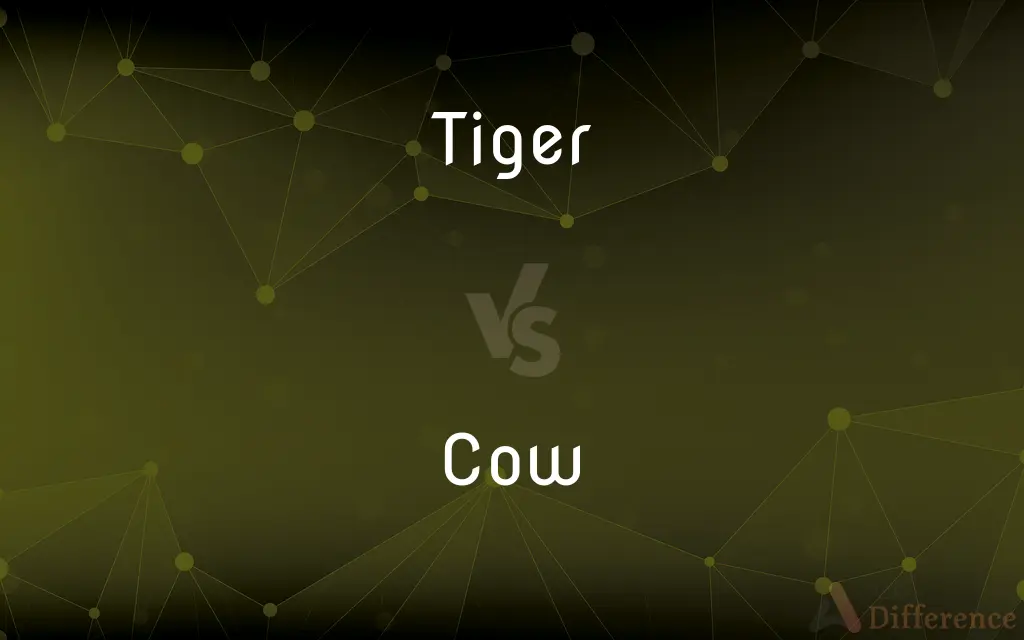Tiger vs. Cow — What's the Difference?
By Tayyaba Rehman — Updated on January 16, 2024
A tiger is a large carnivorous wild cat known for its strength and striped fur, while a cow is a domesticated herbivore known for its role in agriculture, providing milk and meat.

Difference Between Tiger and Cow
Table of Contents
ADVERTISEMENT
Key Differences
Tigers are large predatory cats belonging to the genus Panthera, known for their distinctive orange fur with black stripes. They are apex predators, primarily found in Asia, and are solitary in nature. In contrast, Cows are domesticated bovines, often raised in herds for agricultural purposes. Cows are significant to human agriculture for their milk, meat, and as draft animals.
The diet of a Tiger consists mainly of meat; they are carnivores that hunt and feed on other animals, such as deer and wild boar. Cows, on the other hand, are herbivores, feeding primarily on grasses, plants, and grains. Their digestive system is specialized for fermenting plant-based food, which is processed in their complex stomach, consisting of four compartments.
Tigers are known for their powerful physique, which includes strong muscular bodies, sharp claws, and teeth adapted for hunting and consuming prey. They play a crucial role in maintaining the balance of their ecosystems as top predators. Cows are generally more docile and have been selectively bred by humans over thousands of years for various traits like milk production, meat yield, and docility.
In terms of behavior, Tigers are solitary animals and are highly territorial, often requiring large areas of habitat for hunting and survival. Cows, being domesticated, live in groups and are dependent on humans for their care and feeding. They have been integrated into various cultural and economic aspects of human society.
Conservation status also differs greatly; many Tiger species are endangered due to habitat loss and poaching. Efforts are ongoing for their conservation and habitat protection. Cows are widespread globally due to their domestication and are not considered endangered, playing a significant role in agricultural economies.
ADVERTISEMENT
Comparison Chart
Classification
Carnivorous wild cat
Domesticated herbivore bovine
Habitat
Primarily in Asia
Domesticated worldwide
Diet
Carnivore (hunts for meat)
Herbivore (eats grasses, plants)
Role in Ecosystem
Apex predator, maintains balance
Integral to human agriculture
Conservation Status
Many species endangered
Not endangered, widely domesticated
Compare with Definitions
Tiger
Solitary and territorial in nature.
Each tiger requires a vast territory for its survival.
Cow
Generally docile and raised in herds.
The herd of cows peacefully grazed in the meadow.
Tiger
Endangered species needing conservation efforts.
Conservation programs are crucial for the tiger's survival.
Cow
Integral to many agricultural societies.
In many cultures, the cow is a symbol of prosperity and fertility.
Tiger
Apex predator in its natural habitat.
The tiger plays a crucial role in maintaining the ecological balance.
Cow
Herbivore, primarily feeding on grass.
Cows grazing in the pasture are a common rural sight.
Tiger
Known for its strength and powerful hunting skills.
The tiger's hunting prowess is unparalleled in the animal kingdom.
Cow
Important for milk and meat production.
The dairy farm relies on cows for milk supply.
Tiger
The tiger (Panthera tigris) is the largest living cat species and a member of the genus Panthera. It is most recognisable for its dark vertical stripes on orange-brown fur with a lighter underside.
Cow
(mining) A chock: a wedge or brake used to stop a machine or car.
Tiger
A large carnivorous feline mammal (Panthera tigris) of Asia, having a tawny coat with transverse black stripes.
Cow
The mature female of cattle of the genus Bos.
Tiger
Any of various similar wild felines, such as the jaguar, mountain lion, or lynx.
Cow
The mature female of certain other large animals, such as elephants, moose, or whales.
Tiger
A person regarded as aggressive, audacious, or fierce.
Cow
To frighten or subdue with threats or a show of force.
Tiger
Panthera tigris, a large predatory mammal of the cat family, indigenous to Asia.
Cow
(uncommon) Beef: the meat of cattle as food.
The only meat I eat is cow.
Tiger
A male tiger; as opposed to a tigress.
Cow
(uncommon) Any bovines or bovids generally, including yaks, buffalo, etc.
Tiger
(heraldry) A representation of a large mythological cat, used on a coat of arms.
Cow
(biology) A female member of other large species of mammal, including the bovines, moose, whales, seals, hippos, rhinos, manatees, and elephants.
Tiger
A leopard.
Cow
A woman considered unpleasant in some way, particularly one considered nasty, stupid, fat, lazy, or difficult.
Tiger
A relatively small country or group of countries with a fast-growing economy.
Cow
To intimidate; to daunt the spirits or courage of.
Con artists are not cowed by the law.
Tiger
(obsolete) A servant in livery, who rides with his master or mistress.
Cow
The mature female of bovine animals.
Tiger
(figurative) A ferocious, bloodthirsty and audacious person.
Cow
The female of certain large mammals, as whales, seals, etc.
Tiger
A kind of growl or screech, after cheering.
Three cheers and a tiger
Cow
A chimney cap; a cowl
Tiger
A pneumatic box or pan used in refining sugar.
Cow
A wedge, or brake, to check the motion of a machine or car; a chock.
Tiger
A tiger moth in the family Arctiidae.
Cow
To depress with fear; to daunt the spirits or courage of; to overawe.
To vanquish a people already cowed.
THe French king was cowed.
Tiger
A tiger beetle.
Cow
Female of domestic cattle:
`moo-cow' is a child's term
Tiger
Any of the three Australian species of black-and-yellow striped dragonflies of the genus Ictinogomphus.
Cow
Mature female of mammals of which the male is called `bull'
Tiger
A tiger butterfly in tribe Danaini, especially subtribe Danaina
Cow
A large unpleasant woman
Tiger
A final shouted phrase, accompanied by a jump or outstretched arms, at the end of a cheer.
Cow
Subdue, restrain, or overcome by affecting with a feeling of awe; frighten (as with threats)
Tiger
A very large and powerful carnivore (Felis tigris) native of Southern Asia and the East Indies. Its back and sides are tawny or rufous yellow, transversely striped with black, the tail is ringed with black, the throat and belly are nearly white. When full grown, it equals or exceeds the lion in size and strength. Called also royal tiger, and Bengal tiger.
Cow
A domesticated bovine used in agriculture.
The cow in the field provides milk for the farm.
Tiger
Fig.: A ferocious, bloodthirsty person.
As for heinous tiger, Tamora.
Tiger
A servant in livery, who rides with his master or mistress.
Tiger
A kind of growl or screech, after cheering; as, three cheers and a tiger.
Tiger
A pneumatic box or pan used in refining sugar.
Tiger
A fierce or audacious person;
He's a tiger on the tennis court
It aroused the tiger in me
Tiger
Large feline of forests in most of Asia having a tawny coat with black stripes; endangered
Tiger
A large carnivorous cat with distinctive stripes.
The tiger roamed the jungle majestically.
Common Curiosities
How do tigers hunt?
Tigers hunt by stalking and then pouncing on their prey.
Can cows be found in the wild?
Cows are domesticated, though there are wild bovines.
What family does the tiger belong to?
The tiger belongs to the Felidae (cat) family.
Are cows wild animals?
No, cows are domesticated animals.
What is the lifespan of a cow?
Cows typically live for about 20 years.
What do tigers primarily eat?
Tigers are carnivores, primarily eating meat.
Are all tigers orange with black stripes?
Most are, but white tigers are a rare genetic variant.
What products do we get from cows?
We get milk, meat, leather, and sometimes use them for labor.
Do cows have a special digestive system?
Yes, they have a four-chambered stomach for digesting plant material.
What are the major threats to tigers in the wild?
Major threats include habitat loss, poaching, and conflict with humans.
How fast can a tiger run?
Tigers can reach speeds of up to 30-40 mph.
What is the social structure of cows?
Cows are social animals and often live in herds.
Where do tigers live in the wild?
Tigers primarily live in Asia, in habitats ranging from rainforests to grasslands.
Are cows used in agriculture worldwide?
Yes, cows play a significant role in agriculture globally.
How many tiger species are there?
There are six living tiger subspecies.
Share Your Discovery

Previous Comparison
Regiment vs. Brigade
Next Comparison
Asleep vs. SleepAuthor Spotlight
Written by
Tayyaba RehmanTayyaba Rehman is a distinguished writer, currently serving as a primary contributor to askdifference.com. As a researcher in semantics and etymology, Tayyaba's passion for the complexity of languages and their distinctions has found a perfect home on the platform. Tayyaba delves into the intricacies of language, distinguishing between commonly confused words and phrases, thereby providing clarity for readers worldwide.
















































